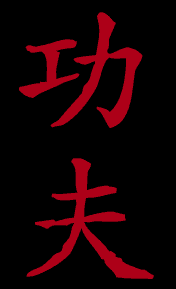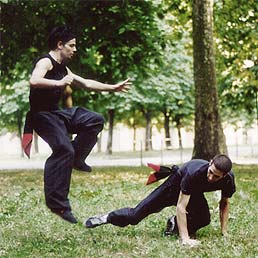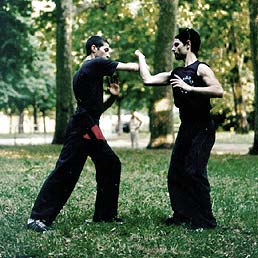|
|
 |
Kung
Fu
|
 |
 Today,
here in the West, the term “kung-fu” has come to signify
any number of systems or styles through which Chinese martial
arts are taught and studied. In the Chinese language the term
“kung-fu” has a meaning in common usage that may include
any disciplined skill or technique developed over time and may
be applied to any human activity besides Chinese self-defense
arts. Anyone who refines creative physical activity to a high
degree can be said to have developed “kung-fu”: a
skilled and efficient housewife, photographer, sculptor, an
Olympic athlete, a chef, joiner, surgeon, shoemaker, tailor,
secretary, machinist, etc., could each be said to have “kung-fu”.
Watching someone who has developed kung-fu working, often the
dynamics of their activity appear simple and effortless to such
an extent that the person may appear to be doing very little
or nothing and yet be highly productive. Today,
here in the West, the term “kung-fu” has come to signify
any number of systems or styles through which Chinese martial
arts are taught and studied. In the Chinese language the term
“kung-fu” has a meaning in common usage that may include
any disciplined skill or technique developed over time and may
be applied to any human activity besides Chinese self-defense
arts. Anyone who refines creative physical activity to a high
degree can be said to have developed “kung-fu”: a
skilled and efficient housewife, photographer, sculptor, an
Olympic athlete, a chef, joiner, surgeon, shoemaker, tailor,
secretary, machinist, etc., could each be said to have “kung-fu”.
Watching someone who has developed kung-fu working, often the
dynamics of their activity appear simple and effortless to such
an extent that the person may appear to be doing very little
or nothing and yet be highly productive.
This impression often mystifies those of the general public
who have not developed themselves in any specific direction.
Particularly in an era when so much information is obtainable
at the push of a button, it is easy for those people to believe
that such skill may also be acquired quickly and with little
effort. Nothing could be farther from the truth. As anyone who
has developed any physical or mental skill to any degree knows,
the development of that ability is neither a quick process nor
is it easy. On the contrary, all self-development takes constancy,
determination, humility, perseverance, energy, plain old-fashioned
hard work and lots and lots of time.
 Learning
how to practice traditional Chinese Kung-Fu is a time-tested
and verified form of self-development. Though based on simple
principles of coordination of intention, energy and movement,
practicing kung-fu is not possible without great dedication
to the refinement of one’s physical and mental capability.
To achieve results a student needs to be guided by an experienced
instructor, over many years. Much more time is required to learn
how to train, practice and apply Chinese Kung-Fu than most people
would ever dream of spending in normal professional preparation.
Many beginners begin to feel as if they know everything in the
first five to ten years only to realize that their understanding
is much like a mirage in a desert: very clear and distinct in
appearance but of no true substance. This is a necessary and
fundamental step in learning kung-fu. That the student becomes
aware of taking this step is the responsibility of the instructor.
Part of his work is to illuminate the student to the knowledge
that knowing the sequence of movements of the forms and having
the ability to apply them is not sufficient. Understanding the
internal and external aspects of the movements and knowing how
not to fight is the point at which one truly begins to practice
kung-fu. Learning
how to practice traditional Chinese Kung-Fu is a time-tested
and verified form of self-development. Though based on simple
principles of coordination of intention, energy and movement,
practicing kung-fu is not possible without great dedication
to the refinement of one’s physical and mental capability.
To achieve results a student needs to be guided by an experienced
instructor, over many years. Much more time is required to learn
how to train, practice and apply Chinese Kung-Fu than most people
would ever dream of spending in normal professional preparation.
Many beginners begin to feel as if they know everything in the
first five to ten years only to realize that their understanding
is much like a mirage in a desert: very clear and distinct in
appearance but of no true substance. This is a necessary and
fundamental step in learning kung-fu. That the student becomes
aware of taking this step is the responsibility of the instructor.
Part of his work is to illuminate the student to the knowledge
that knowing the sequence of movements of the forms and having
the ability to apply them is not sufficient. Understanding the
internal and external aspects of the movements and knowing how
not to fight is the point at which one truly begins to practice
kung-fu.
| A thorough awareness and
comprehension of one’s limitations and weaknesses
is where the study of kung-fu begins. The development
and refinement of one’s capabilities and strengths
is the path along which kung-fu travels. kung-fu’s
destination is the fluid union of the self, weaknesses
and strengths, body and mind/spirit, water and fire, yin
and yang. A kung-fu master may show his or her achievement
through having developed the capability to respond appropriately
to any situation with calm, poise and sincerity, without
violence, anger or unnecessary action.
|
 |
.
 |
last update: feb 12 - 2004 |
|
|